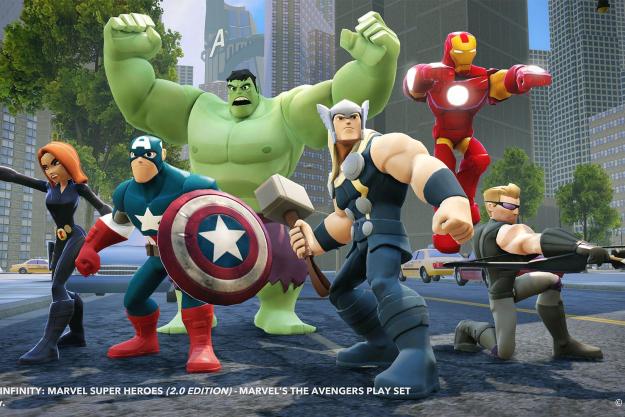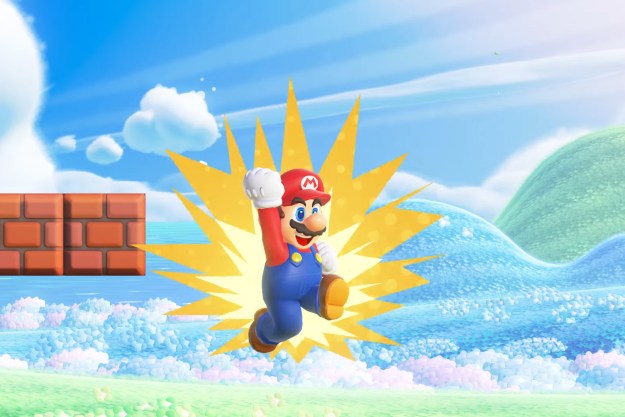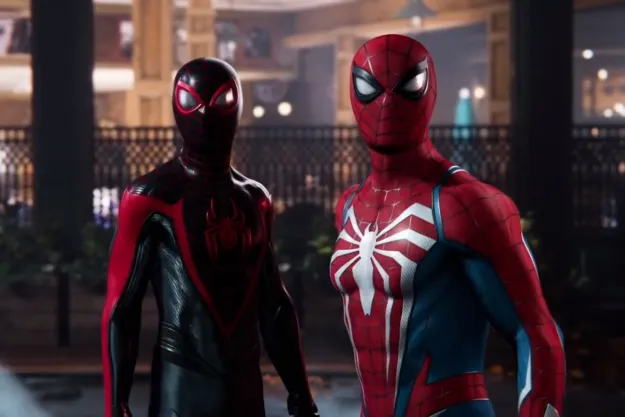
“Disney Infinity: Marvel Super Heroes offers endless creative possibilities, but limited interactivity between characters.”
- Fun, fan-friendly narrative with a great script
- Surprisingly powerful world-building experience
- Lots of replay value
- Relatively brief storylines
- Limited interactivity between characters
- Steep learning curve for Toy Box mode
At some point in Disney’s accumulation of just about every pop culture touchstone in the entertainment landscape, Disney Infinity: Marvel Super Heroes became inevitable. When one company has the license to use Mickey Mouse, Iron Man, Captain Jack Sparrow, Buzz Lightyear, and the cast of Frozen, it’s not a question of if they’ll ever end up on the same screen, but when it’s going to happen.
Disney Interactive Studios set the stage with 2013’s collectible-figure adventure Disney Infinity, which allowed players to take control of a host of popular characters from its Disney and Pixar properties. With Marvel Super Heroes, Disney throws open the doors to allow its stable of Marvel Comics characters in and encourages more mix-and-match adventures with Spider-Man, The Avengers, and various other heroes and villains right alongside their iconic Disney and Pixar counterparts.
As a follow-up to the well-received Disney Infinity, Marvel Super Heroes carries over much of what worked for its predecessor.
It falls a bit short of the no-holds-barred mashup of Marvel, Disney, and Pixar characters that one might hope for, but Marvel Super Heroes manages to offer two distinct, immersive experiences that provide more entertainment than one might expect from a game marketed for a young audience.
As a follow-up to the well-received Disney Infinity, Marvel Super Heroes carries over much of what worked for its predecessor. Gameplay is divided between two modes: narrative-based, open-world “playset” adventures tailored to specific groups of characters (i.e., The Avengers or Guardians of the Galaxy), and a free-form “Toy Box” environment that mixes the world-building of Minecraft with simple, logic-based programmable objects and interactive elements culled from Disney’s properties that can be unlocked in various ways.
It’s in the playset adventures where the limitations on the game model come into play, with a specific group of characters able to participate in each narrative. Iron Man, Hulk, Captain America, Black Widow, and other characters associated with The Avengers are welcome to join the storyline and be mixed and matched at will during playset adventures, but other characters – such as Spider-Man or Groot, in this particular example – aren’t compatible with The Avengers’ playset. A small number of characters (like Rocket Raccoon and Hulk) are playable in multiple playsets if you unlock them via in-game quests, but the majority of characters are only compatible with a single playset.
This is something worth keeping in mind if you’re interested in playing as a certain character that doesn’t come packaged with a playset module (the plastic module necessary for each playset adventure). If you want to participate in the Guardians of the Galaxy narrative while playing as Groot, for example, you’ll need to own the individual Groot figure, the Guardians of the Galaxy playset pack (which includes the playset module), and the Disney Infinity: Marvel Super Heroes starter set (which includes the game and the plug-in base that reads the physical figures and playsets). It can be confusing, but thankfully, each solo figure is accompanied by a chart on the back of the box detailing its associated/supported playset (or playsets).

As for the gameplay in the playset adventures, superhero fans will find a lot to like in the storylines scripted by veteran Marvel Comics scribe Brian Bendis, who knows the characters well. The narrative is jam-packed with cameos that are occasionally determined by the specific characters controlled by the player at particular points. When you play as Iron Man, the computer-controlled characters that pop up can differ from those that appear while playing as Black Widow, Hulk, or other characters. The primary thread of the story remains unchanged, but the supporting cast can shift according to your choice of player-controlled character.
The playsets also allow for multiplayer adventures, meaning two characters from a corresponding playset can be used cooperatively, with both participating in the narrative. This is for local play only, though; online play will have to wait for future Infinity adventures.
Total playing time to make it through the central narrative of each playset adventure is around four to six hours, and much of the experience consists of getting a mission from one computer-controlled supporting character, traveling to the mission location, fighting waves of enemies, and then seeking out another mission. Characters gain experience and can be leveled up in various ways, offering an opportunity for personalization of each character as it evolves. Despite the short narrative, the cornucopia of side quests, challenges, and character-specific collectibles scattered throughout the map keep things interesting and offers a surpising amount of replay value, as many of these missions unlock additional content in either the playset adventure or the Toy Box mode.
Toy Box is the real jewel of Disney Infinity: Marvel Super Heroes, expanded from its appearance in the previous game but with an unchanged focus.
That’s the real jewel of Disney Infinity: Marvel Super Heroes. Toy Box is expanded from its appearance in the previous game, but the focus is unchanged. Players have all the tools they need to come up with a seemingly endless variety of creative building and play options. Floors, walls, and just about every aspect of the environment in Toy Box can be created, destroyed, moved, or otherwise assembled in any way imaginable. That’s along with a menu of additional elements – both interactive and decoration – that grows as you interact in either the Toy Box or Playset modes
Some objects even use simple logic (i.e., activating when a character enters a room or when jumped on or otherwise “touched”), making it possible to create complicated, Rube Goldberg-esque systems within a particular Toy Box project. You can create entire worlds in this mode, but you can also take advantage of these more intelligent build options to create games of your own. And as with the first Infinity, playset restrictions don’t apply in Toy Box. You can use any of your characters here, and mix-and-match as you please for a more all-encompassing mash-up experience.
The worlds created using the Toy Box mode can then be uploaded to Disney’s cloud-based server and downloaded by other Disney Infinity: Marvel Super Heroes players. Once in the cloud, projects are voted on by fellow players and made searchable via various filters, offering a nice opportunity for user-generated add-ons. Everything from simple, platform-style games to more impressive, narrative-based adventures were available in the cloud even prior to launch.
The Toy Box mode of Disney Infinity is a surprisingly robust, wide-open world, and while it lacks the narrative-based experience provided by the character-specific playsets, it makes up for it with seemingly endless creative possibilities. The mode makes good use of the controls and allows a relatively wide range of creative options, but it’s worth noting that it does seem to assume some familiarity with Toy Box mode from the previous iteration of Disney Infinity, with the tutorial offering a basic walkthrough and then leaving the player to investigate the other creative options that are available. This can make for a steep learning curve for newcomers to the Toy Box environment.
Disney has also made available an array of physical “Power Disc” add-ons that can be purchased individually. The Power Discs are packaged so as to keep their contents a secret until after they’re bought and opened, and they unlock everything from minigames that are playable with your collection of characters to new interactive objects that the characters can use in Toy Box mode. There are even team-up opportunities with additional characters during playset adventures. One particular Power Disc, for example, makes it possible to play a tower-defense minigame set in Thor’s home realm of Asgard using any of the characters you own.
Difficult to judge as a singular product, Disney Infinity: Marvel Super Heroes often feels like two very different, distinct experiences. Its narrative playset adventures conclude a bit too soon and don’t offer the fully interactive crossover that players might be hoping for, but its Toy Box mode gives you all the tools necessary to create your own mash-up (or anything else you can conceive of). There’s just a bit of a steep learning curve to creation – even for adult players.
The two modes will likely appeal to two very different types of players, and though Disney has done an admirable job of fleshing out each portion of the game, they each fall a little short of their potential despite the impressive, entertaining experience that Marvel Super Heroes offers.
Highs
- Fun, fan-friendly narrative with a great script
- Surprisingly powerful world-building experience
- Lots of replay value
Lows
- Relatively brief storylines
- Limited interactivity between characters
- Steep learning curve for Toy Box mode
Editors' Recommendations
- Every character confirmed in Marvel Rivals
- Suicide Squad: Kill the Justice League: release date, trailers, gameplay, and more
- All hidden chest locations in Super Mario RPG
- All Captain Toad locations in Super Mario Bros. Wonder
- How to get Hero Tokens in Spider-Man 2







